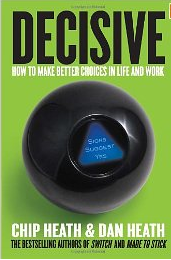 Chip and Dan Heath have two best sellers behind them and I suspect soon a third one. I am fortunate to know Chip, and received a pre-release of Decisive, their new book to be released on March 26. It is a must read for any business leader.
Chip and Dan Heath have two best sellers behind them and I suspect soon a third one. I am fortunate to know Chip, and received a pre-release of Decisive, their new book to be released on March 26. It is a must read for any business leader.
Of the many business decisions, it is often said that the most important decisions are people decisions. So the question is: How do we make better talent decisions when we know that we get it wrong half of the time? To reassure you, poor decisions are not only made in the field of talent management. The book mentions that doctors categorizing themselves as “completely certain” about a diagnosis were wrong 40% of the time.
In order to address this issue, to get it right, know what causes us to make wrong decisions. In Decisive, this is explained as “the four villains of decision making.” One that resonates with us a great deal, as we think about talent decisions, is the confirmation bias. The confirmation bias is the act of making emotional decisions and only gathering information that supports such decisions. The difficulty here is that these decisions appear to be researched and scientific, but when you look closer, they end up being subject to the confirmation bias.
Let’s look at an example and see how you can avoid the confirmation bias for you and your organization:
A hiring manager interviews several candidates and makes his mind up on one of them. This candidate is the one, the best, the perfect fit. Now as too-often happens in organizations, the hiring manager believes that the decision has been made to hire the candidate and sees the traditional reference and background checks as mere formalities. That is why when the drug test or background check comes back positive, the hiring manager is devastated to find out that their “perfect” candidate is not as perfect as he or she once believed. But, where the confirmation bias best illustrates itself is when the manager performs the reference check themselves. The manager asks the candidate to provide a list of references, tries to reach them himself/herself, only reaches a few, and with those he/she does reach, they have a love fest about how great the candidate is. The manager takes good notes and thus has more details on why this candidate is great.
The issue here is that the manager or even often the recruiters are not seeking the truth on the candidate; they are seeking re-assurance. We at Checkster have often asked a simple question to unmask this: How often have you refused a candidate because of a bad reference check? The numbers are so low that often companies which realize that, and do not fear to be seen as negligent hiring organizations, simply stop doing the traditional reference check.
But what is the solution to the confirmation bias? First, let’s take a look at how to solve it when doing reference checking. As mentioned in the book, one simple practice is to ask factual questions (i.e. How many personal assistants has this executive had over the last five years?) Another solution we recommend at Checkster since the use of automated reference checking made it manageable, is to run reference checks earlier in the process on the two or three final candidates. This is referred to in the book as the “multi-track” approach. It has a huge benefit: the ego of the decision-maker does not become attached to one candidate. Most importantly, the multi-track approach is at the essence of avoiding the confirmation bias, making sure you are not only considering the two options: to hire or not to hire the candidate. It is about offering two or three viable options, not 20 options at the same time that will paralyze you.
But be mindful that those two or three options need to be viable, meaning that they should all be good candidates, not one strong candidate and two other weak fits like recruiters sometimes choose to give the illusion of a multi-track. If you give your hiring managers all the data (interview notes, assessment details, and reference check report) on the viable two to three candidates before they fall in love with one of them and are subject to the confirmation bias, your hiring accuracy will increase dramatically.